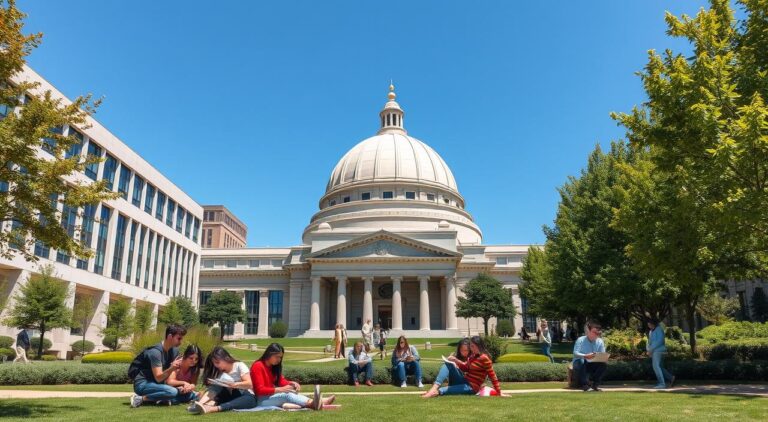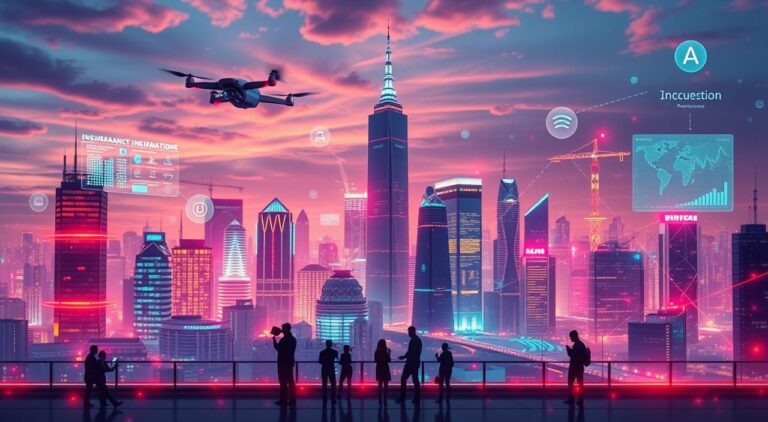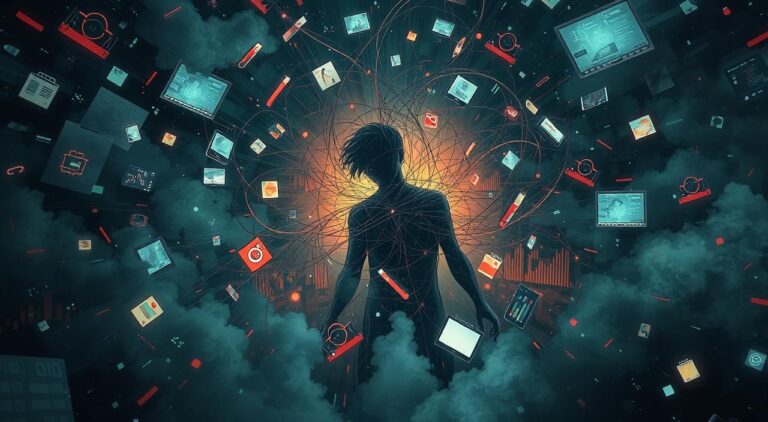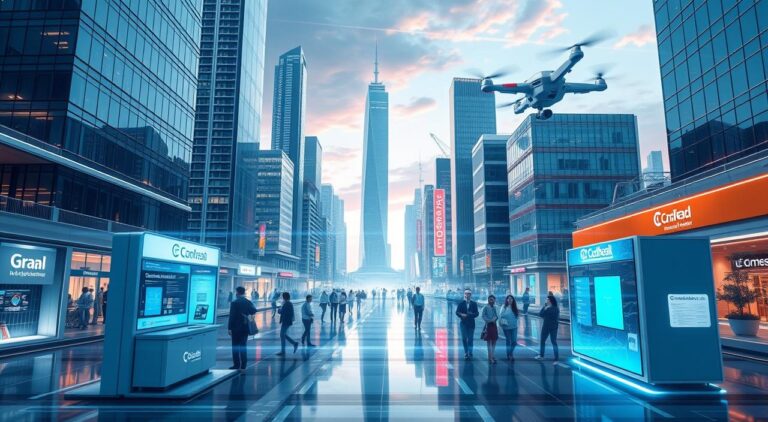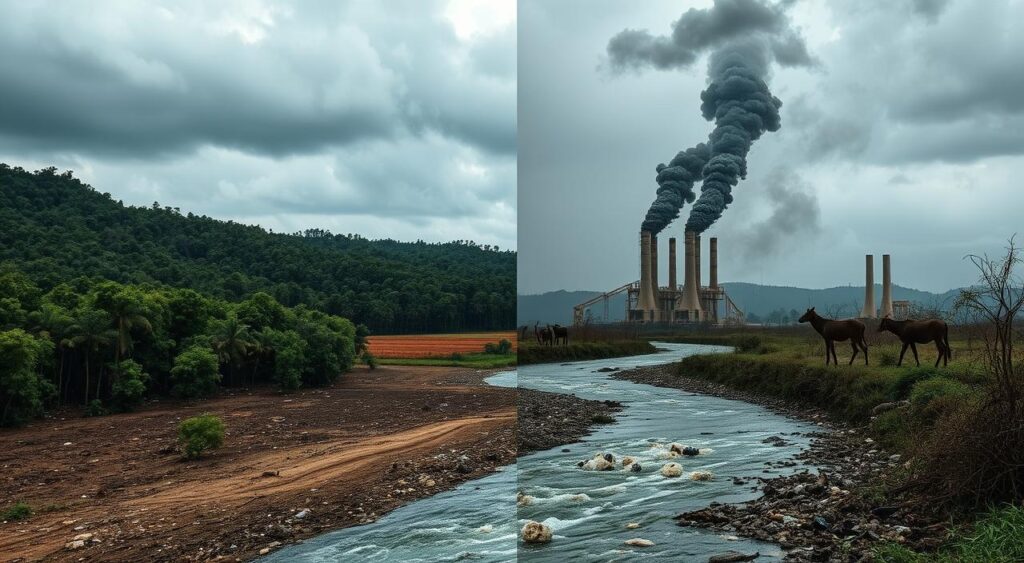
How much have our actions truly impacted our planet? As the world’s population grows and our use of resources increases, the damage to the environment is clear. Climate change and biodiversity loss are just a few examples of the far-reaching effects of human development.
It’s a harsh truth that over 80% of the world’s people live in countries that use more resources than they can replace. This unsustainable path has led to a significant increase in greenhouse gases. As a result, the global average temperature has risen by about 1°C in the last 270 years, and emissions keep going up despite efforts to stop climate change.
Key Takeaways
- Human activities have significantly impacted the environment, leading to climate change, biodiversity loss, and resource depletion.
- Over 80% of the world’s population lives in countries running ecological deficits, using more resources than their ecosystems can renew.
- Greenhouse gas emissions have continued to rise, with the global average temperature increasing by about 1°C in the past 270 years.
- Industrialized countries have high per capita carbon emissions, while emerging economies are experiencing surges in emissions.
- Population growth, urbanization, and unsustainable consumption patterns are driving environmental degradation and climate change.
Understanding Human Environmental Impact in the Modern Era
In today’s world, our actions have a big impact on the environment. Environmental Impact Assessment helps us see how our development affects nature. It shows us how our actions connect with the natural world.
Defining Environmental Impact Assessment
Environmental Impact Assessment (EIA) is a detailed process. It looks at the possible effects of projects on the environment and society. This helps us make better choices and reduce harm to nature.
Historical Context of Human Development
Over time, our growth has put a lot of pressure on Earth’s resources. As our population and technology have grown, we’ve explored more of the planet. This has harmed forests, habitats, and natural resources.
Current State of Global Environmental Health
Now, the world faces many environmental problems. Climate change is causing warmer temperatures and more extreme weather. Pollution harms our health and the planet. Biodiversity loss is also a big issue, with many species at risk.
The Human Development Index (HDI) measures well-being but ignores environmental impact. Recent data shows HDI scores are falling. This shows we need to adopt sustainable practices for a better future.
“The greatest threat to our planet is the belief that someone else will save it.” – Robert Swan
What are the negative impacts of human development?
Our quest for progress and economic growth has harmed the environment. Key negative effects include pollution, deforestation, resource depletion, and habitat destruction.
Pollution, like greenhouse gas emissions and industrial waste, has worsened climate change. In 2021, global carbon dioxide emissions hit 36.4 billion metric tons, warming our planet.
Deforestation, caused by logging and agriculture, has harmed ecosystems. It’s estimated that about one million species face extinction due to us.
Our use of resources has strained the planet. The global ecological footprint is 1.7 times the Earth’s biocapacity, showing we use more than we can replace.
Habitat destruction, from urbanization and infrastructure, has harmed wildlife. It disrupts ecosystems, worsening biodiversity loss.
These impacts threaten our planet’s health and our future. We must adopt sustainable practices and find a balance to protect our environment.
“The greatest threat to our planet is the belief that someone else will save it.”
| Negative Impact | Statistics |
|---|---|
| Pollution | Global carbon dioxide emissions reached 36.4 billion metric tons in 2021. |
| Deforestation | Approximately one million plant and animal species are currently threatened with extinction due to human activities. |
| Resource Depletion | The global ecological footprint is estimated to be 1.7 times the Earth’s biocapacity. |
| Habitat Destruction | Urbanization, infrastructure development, and land-use changes have disrupted delicate ecosystems. |
The Growing Crisis of Climate Change and Global Warming
Human activities have a big impact on our planet. Over the last century, global temperatures have gone up by about 2°F (1.1°C). This rise is mainly because of greenhouse gas emissions from human activities. Now, the amount of carbon dioxide in the air is 50% higher than before the Industrial Revolution.
Greenhouse Gas Emissions and Temperature Rise
Greenhouse gases like carbon dioxide, methane, and nitrous oxide are the main cause of global warming. These gases trap heat, making the Earth’s temperature go up. This leads to many climate change effects. If we keep emitting at current levels, global warming could hit 1.5°C by 2030 to 2052. The Paris Agreement aims to prevent this.
Impact on Weather Patterns and Natural Disasters
Climate change is changing weather patterns and making natural disasters worse. We see longer wildfire seasons, stronger storms, rising sea levels, and extreme weather. These events threaten human health and safety. Research shows that 37% of heat-related deaths are due to climate change.
Extreme weather in vulnerable areas is 15 times deadlier than in safer places.
Future Climate Scenarios and Projections
The Intergovernmental Panel on Climate Change’s Sixth Assessment Report says 3.6 billion people live in areas at high risk from climate change. To meet the Paris Agreement, we need to cut emissions by 7.6% every year from 2020 to 2030. If we don’t act fast, the consequences could be devastating. By 2030-2050, we could see 250,000 more deaths each year from hunger, malaria, diarrhea, and heat stress.
“Climate change is the defining challenge of our time. The choices we make today will determine the world our children and grandchildren inherit.”
Deforestation and Habitat Destruction
Human activities like deforestation and habitat destruction harm vital ecosystems. They displace wildlife and reduce biodiversity. Forests are key in fighting climate change by absorbing carbon dioxide.
Deforestation causes about 10% of greenhouse gas emissions. Illegal logging adds 15% to 30% of timber production. The main reasons for forest loss are agriculture, logging, overgrazing, and fuel extraction.
Wildlife faces huge challenges due to deforestation and habitat loss. Orangutans in Sumatra and Borneo have lost 25% of their population in a decade. Pygmy sloths went from 500 to 70 between 2001 and 2012. Monarch butterflies are now endangered due to habitat loss and climate change.
- Deforestation leads to the extinction of approximately 135 plants, animals, and insects daily.
- Around 50% of all land species reside in rainforests, with 80% of amphibious species, 75% of birds, and almost 70% of mammals living in these habitats.
- Habitat loss poses a significant threat to 85% of all species listed on the IUCN Red List, which includes species classified as “Threatened” and “Endangered.”
We need sustainable land use and conservation to fight deforestation and habitat loss. Preserving ecosystems protects biodiversity and helps combat climate change. It also prevents future zoonotic disease outbreaks.
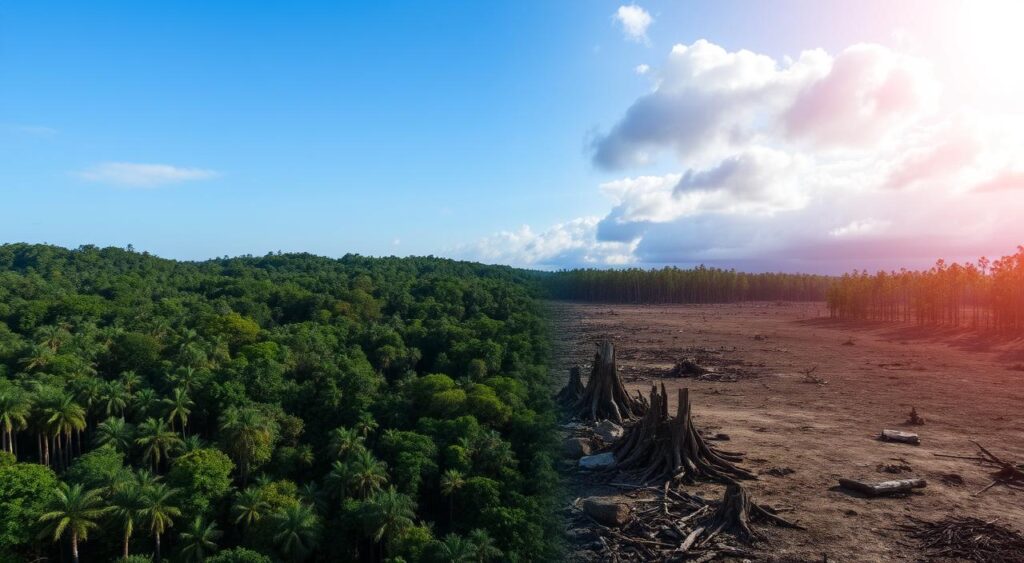
“Deforestation is a major contributor to the climate crisis, and its impacts on wildlife and indigenous communities are devastating. We must prioritize sustainable land use and conservation to protect our planet’s precious ecosystems.”
Environmental Pollution and Its Consequences
Environmental pollution is a big threat to our health and the planet. It affects everything from the air we breathe to the water we drink and the soil that grows our food. Let’s look at the different types of pollution and how they harm our world.
Air Pollution and Respiratory Health
Air pollution causes many respiratory diseases and early deaths worldwide. The World Health Organization says in 2012, 23% of deaths, or 12.6 million people, were due to pollution. Most of these deaths happened in countries with lower incomes.
Pollutants like sulfur dioxide and carbon monoxide from cars and factories harm our lungs and hearts.
Water Contamination and Ocean Pollution
Water pollution is a big problem, caused by things like agricultural runoff and industrial waste. Pollutants like heavy metals and microplastics get into our water and oceans. This harms fish and other sea creatures and can even get into our food.
By 2050, there could be more plastic than fish in the oceans.
Soil Degradation and Chemical Pollution
Soil pollution from industrial activities and pesticides hurts our food and the environment. Exposure to pollutants like bisphenol A can cause serious health problems.
We need to tackle pollution with new policies, technology, and community efforts. Protecting our environment is key to a healthy future for all living things.
| Pollutant | Health Impact | Mitigation Efforts |
|---|---|---|
| Air Pollution | Respiratory diseases, cardiovascular issues, cancer | Transition to renewable energy, stricter vehicle emissions standards, urban tree planting |
| Water Contamination | Waterborne diseases, disruption of aquatic ecosystems, bioaccumulation in food chain | Improved wastewater treatment, reduced use of pesticides and fertilizers, plastic waste management |
| Soil Degradation | Cardiovascular diseases, neurological disorders, food safety issues | Sustainable agricultural practices, remediation of contaminated sites, proper disposal of hazardous waste |
“Pollution, environmental degradation, and climate change are interconnected planetary crises negatively impacting human and animal health.”
We must tackle environmental pollution to ensure a healthy future for our planet and ourselves.
Resource Depletion and Overconsumption
Human development is speeding up, and our impact on Earth’s resources is alarming. Our unsustainable ways of using resources threaten our planet’s future.
Our consumption is huge. Since 1990, over 420 million hectares of forests have been lost. This is mainly due to logging. Also, 34% of fish populations are overfished, causing a drop in fish stocks. In North America, people use 90 kilograms of resources daily, much more than Europeans or Africans.
The difference in how much we consume is clear. 21 of Earth’s 35 major aquifers are losing water due to too much use. The world extracts 50 billion tons of sand yearly for buildings, harming rivers and oceans.
Our actions have big consequences. 80% of the world’s energy comes from non-renewable sources, risking our economy. Renewable resources like forests and fish are also being used too much. The United States alone produces 287 pounds of plastic waste per person every year, adding to the plastic problem.
We must change our ways to save our planet. We need to use resources wisely and manage them better. This is key to keeping our ecosystems in balance.
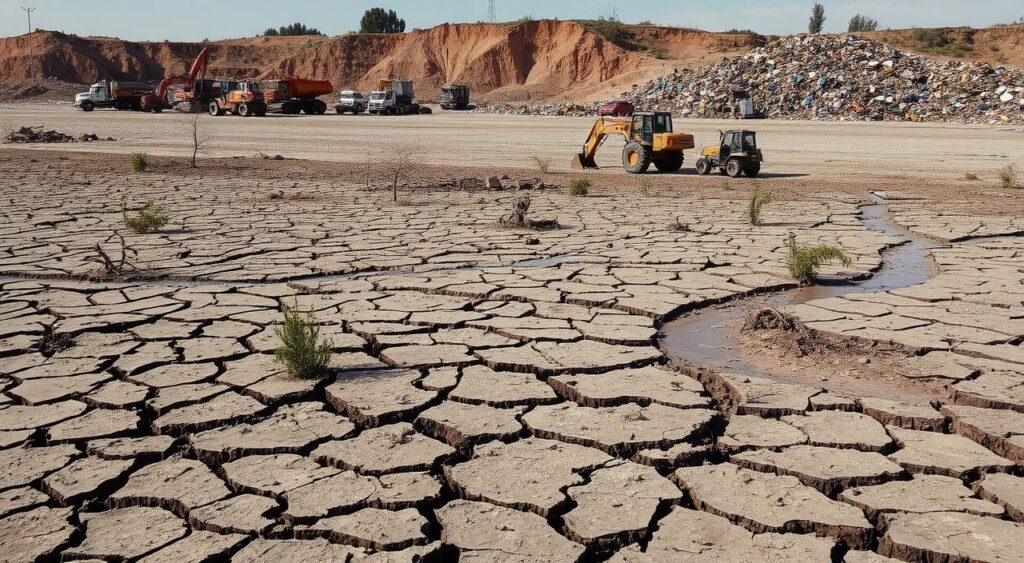
“If current consumption and production patterns remain the same and with a rising population, by the 2050s, we will need the equivalent of more than two Earths to support us.”
Biodiversity Loss and Species Extinction
Human development has harmed our planet, leading to biodiversity loss and species extinction. About one million plant and animal species face extinction. They suffer from habitat loss, overuse, pollution, and invasive species, all caused by our drive for progress.
Endangered Species Statistics
The numbers are shocking. Land use changes, mainly for food, cause 30% of biodiversity loss. Overfishing and hunting account for 20%. Climate change and pollution add 14% and 6%, respectively. Invasive species are responsible for 11%.
Vertebrate populations have dropped by 60% globally since 1970. The biggest declines are in freshwater habitats (83%) and South and Central America (89%). Species loss rates are 100 to 10,000 times higher than natural rates.
Ecosystem Disruption
Biodiversity loss has severe effects on ecosystems. It disrupts food chains and ecosystem services. This threatens human health and well-being, including food security and disease treatments.
Impact on Food Chains
Half of the world’s land is used for agriculture, with 77% for livestock. This has harmed the natural world, with up to one million species facing extinction. Losing biodiversity threatens our future, as we depend on healthy ecosystems.
“Biodiversity is essential for providing goods and services that support human needs such as food security, energy, medicines, and freshwater. Biodiversity loss is happening at unprecedented rates, impacting human health worldwide.”
Population Growth and Urban Expansion
Our world is growing fast, with more people moving to cities. The United Nations says over half of the world’s population, 4.2 billion, live in cities. This number is expected to jump to 6 billion by 2041. Cities are now facing huge challenges as they try to support so many people.
Urban sprawl is making things worse. It’s causing the loss of natural habitats, more use of resources, and damage to the environment. Studies show it also affects the economy and the quality of life in communities.
We need new, comprehensive solutions to deal with these problems. Leaders must work together to make cities sustainable. They should focus on food security and making sure everyone has access to basic services and infrastructure.
